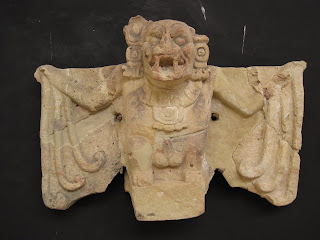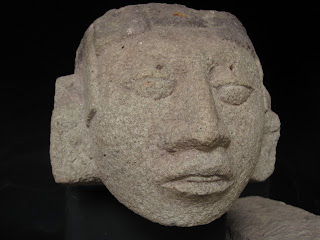

The kingdom was ruled by one dynasty for centuries, kings with names like Great Sun Green Quetzal Macaw, 18 Rabbit, Smoke Jaguar, and Smoke Squirrel. The buildings are stepped pyramids and many in the vicinity have still to be excavated. Stelae in the Great Plaza depict King 18 Rabbit, among others, and there is a ball court, and an immense staircase carved with hieroglyphs.











King Smoke Squirrel built the 63 steps of the Hieroglyphic Staircase. It is now shaded by a protective canvas awning, preserving for a little while more the thousands of hieroglyphs that tell the history of the royal house of Copán.









The jaguar reliefs in the Jaguar Plaza are remarkably Tigger-ish.







When Copán was first excavated in the 19th century it had lain beneath the jungle for centuries and many trees are still rooted in the stones. Many of the carved pieces standing on the site are reproductions and the originals protected in a well-lit museum in the park. At the center of the museum is an immense painted reproduction of the Rosalila temple, discovered intact within the protective shell of a more recently-built structure above it. While you can't see the Rosalila temple in situ, that sense of trees rooting down in ancient stones while still more ancient stones remain untouched beneath eerily collapses the centuries of natural and human endeavor.













At the park entrance a flock of macaws and a troop of agouti maintain a studied indifference to each other.



We spent Honduras' presidential election in the town of Copán Ruinas, as Mike will shortly relate.

No comments:
Post a Comment